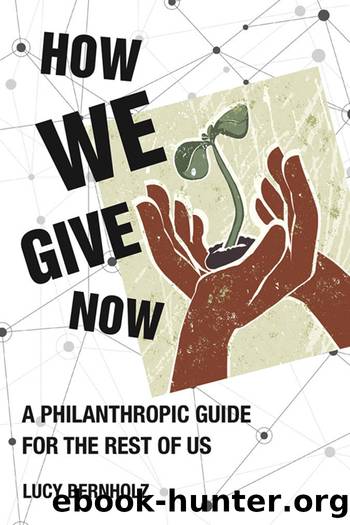How We Give Now by Lucy Bernholz

Author:Lucy Bernholz [Bernholz, Lucy]
Language: eng
Format: epub
Publisher: MIT Press
Published: 2021-09-22T00:00:00+00:00
From Birds to Blood Pressure: Open Humans and Sage Bionetworks
There are lots of ways you can contribute your personal data for health research. So many, in fact, that it can be hard to keep track of whatâs really going on. Imagine that you wanted to contribute data about your blood pressure, heart rate, insulin count, DNA, or level of daily exercise for medical purposes. You can do this via a commercial service, such as 23andMe or Ancestry.com. These two organizations sell you a productâinformation about your genealogyâin exchange for cash, data, and consent. You give them a swab from the inside of your check, a check for about a hundred dollars, and a click on their consent page. These actions allow them to include your digitized DNA data in a dataset that they then charge pharmaceutical companies to access. You will receive a pie chart revealing the places your ancestors may have come from. Youâll also get frequent updates as their databases expand and diversify. Youâve paid for the service of learning about your ancestry, and in consenting to the companyâs rules, you help them profit by selling access to that dataset. Quite simply, youâve paid the company in both money and data.
You donât have to go through a commercial company to do this; in fact, doing so is the most financially expensive way to go. You could contribute DNA data via nonprofit genetics websites or blood pressure and insulin information to any number of nonprofits or online communities. One of these is called Open Humans. It has a complicated history related to the Personal Genome Project (PGP), a Harvard-based effort that launched in the mid-aughts. Since then, Mad Ball, a former doctoral student, has been adapting the organization and its tools to help people share and learn from many types of health data.13 Open Humans offers people a way to store, analyze, and share with others their genomic data, their Twitter feeds, movement information from any form of digital exercise tracker, or microbiome measures. Each person determines what data to share and with whom to share it. The Open Humans community creates software tools that make it easy to connect data from your devices (watches, Fitbits, insulin monitors, phones, etc.) to the online platform and lets you decide who has access and to what, with default settings that keep your data private to you (assuming the database can be secured).14 Mad Ball and the Open Humans community are convinced that data from individuals can be useful for research and treatment; the challenge is to find trusted and safe ways for people to participate. Toward that end, the bulk of Open Humansâ work is on building software and governance tools that appeal beyond the inner circle of do-it-yourself data geeks.
Open Humans is not alone in this quest; itâs part of a much bigger community of people focused on creating new kinds of institutions that we might trust to hold our data and let us determine how it gets used.15 This
Download
This site does not store any files on its server. We only index and link to content provided by other sites. Please contact the content providers to delete copyright contents if any and email us, we'll remove relevant links or contents immediately.
Tools of Titans by Timothy Ferriss(6946)
Change Your Questions, Change Your Life by Marilee Adams(6641)
Deep Work by Cal Newport(5463)
Man-made Catastrophes and Risk Information Concealment by Dmitry Chernov & Didier Sornette(4735)
Big Magic: Creative Living Beyond Fear by Elizabeth Gilbert(4723)
The Slight Edge by Jeff Olson(4722)
Digital Minimalism by Cal Newport;(4540)
The Motivation Myth by Jeff Haden(4524)
Stone's Rules by Roger Stone(4415)
Ego Is the Enemy by Ryan Holiday(3991)
The Laws of Human Nature by Robert Greene(3946)
Tuesdays with Morrie by Mitch Albom(3832)
Rising Strong by Brene Brown(3780)
Eat That Frog! by Brian Tracy(3514)
Skin in the Game by Nassim Nicholas Taleb(3460)
The Money Culture by Michael Lewis(3284)
Skin in the Game: Hidden Asymmetries in Daily Life by Nassim Nicholas Taleb(3264)
Believe It to Achieve It by Brian Tracy & Christina Stein(3206)
Bullshit Jobs by David Graeber(3179)
